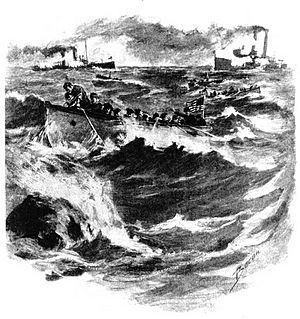Battle of Cienfuegos facts for kids
Quick facts for kids Battle of Cienfuegos |
|||||||
|---|---|---|---|---|---|---|---|
| Part of the Spanish–American War | |||||||
 The cable-cutting expedition at Cienfuegos, Bacon |
|||||||
|
|||||||
| Belligerents | |||||||
| Commanders and leaders | |||||||
| Strength | |||||||
| Unknown | 1 unprotected cruiser 1 gunboat 1 revenue cutter 2 steam launches |
||||||
| Casualties and losses | |||||||
| None | 2 killed 15 wounded |
||||||
The Battle of Cienfuegos, also known as the Raid on Cienfuegos, was a fight during the Spanish–American War. The United States Navy wanted to make its blockade of Cuba stronger. A blockade means stopping ships from going in or out of a port.
Contents
Why was this battle important?
The Spanish forces used undersea cables to talk with other parts of Cuba. They also used them to talk with their commanders. These cables had important connection points near Cienfuegos. The cables linked to Havana and Santiago. They also branched off to other islands like Jamaica.
The cables came out of a house that was easy to find. This house was a main hub for the undersea cable system. The house could be destroyed easily. But this would only cause small damage. It could be fixed quickly. So, the US Navy decided to pull the three cables out of the sea. They planned to cut them in many places. This would stop most of the Spanish communication in Cuba. This kind of damage would be much harder to fix. The cables were nearly two inches thick. This made cutting and fixing them very difficult.
For this mission, three ships were sent. They were the cruiser USS Marblehead, the gunboat USS Nashville, and the revenue cutter USS Windom. Captain Bowman H. McCalla led these ships.
What happened during the battle?
The Marblehead and Nashville started firing at the cable house. This happened at 6:45 a.m. on May 11, 1898. The cable house quickly fell apart from the ships' gunfire. Ten minutes later, at 6:55 a.m., the warships sent out their small work boats. Each boat had only sixteen crew members. This was to keep the number of injured people low.
The Spanish quickly knew what was happening. A Spanish cavalry soldier saw the ships heading to the beach. The first cable was easy to cut. It was out of the line of fire. But the second cable was much harder. Coral formations made it very difficult to grab the cable. It was hard to pull it to the surface to cut. Spanish forces were also closer to the second cable. So, the crew had to deal with both problems.
To stop the increased firing from the Spanish, both warships fired more. As the crew pulled up the second cable, they found a third, smaller cable. After cutting the second, they tried to find this third cable. But they could not. A large group of Spanish soldiers arrived from Cienfuegos. They thought it was a full invasion. By 11:15 a.m., the raid was over.
After a tough, hour-long fight, two cables were cut. The sailors and Marines left. But a third cable near the shore was not touched.
What happened after the battle?
Fifty-two US sailors and Marines received the Medal of Honor. This award was for their "extraordinary bravery and coolness under fire."
See also
 In Spanish: Batalla de Cienfuegos para niños
In Spanish: Batalla de Cienfuegos para niños


